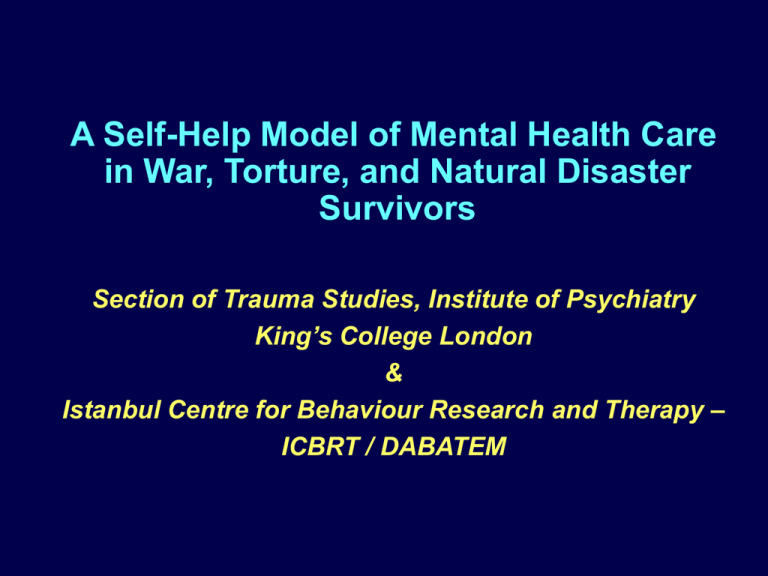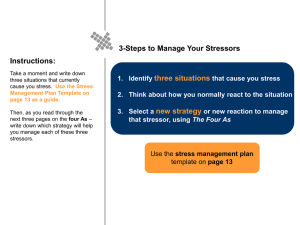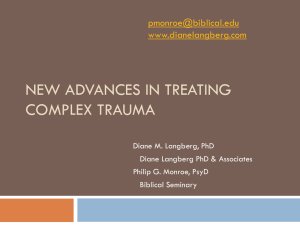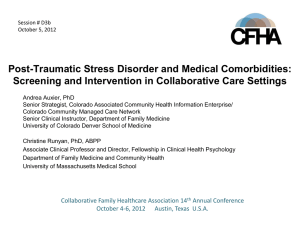ECOTS 2009 keynote address
advertisement

A Self-Help Model of Mental Health Care in War, Torture, and Natural Disaster Survivors Section of Trauma Studies, Institute of Psychiatry King’s College London & Istanbul Centre for Behaviour Research and Therapy – ICBRT / DABATEM Overview of evidence from data based on war, torture, and natural disaster trauma accumulated since 1990 Evidence base – War / torture survivors (1990 – 2007) • 3 studies of torture survivors in Turkey • A study of 2,500 war survivors in former Yugoslavia countries, including – combat veterans – torture survivors – refugees – internally displaced people, and – survivors of aerial bombardment • Single case experimental studies Evidence base – Earthquake survivors (1999 – 2007) • 4 field surveys and 3 epidemiological studies involving more than 6,200 survivors • A study of phenomenology / mechanisms of earthquake trauma in 387 survivors • 9 questionnaire development studies • 2 uncontrolled, 2 randomised controlled treatment studies involving 331 cases • 8 single case experimental studies • Observational data in fieldwork with > 12,000 survivors Starting the journey in mid 1980s – Search for a sound theoretical framework in understanding anxiety disorders Learning theory based on experimental work with animals provide ample evidence for the role of unpredictable and uncontrollable stressors in development of anxiety / fear responses (Mineka & Zinbarg, 2006) Susan Mineka, PhD Northwestern University Parallels between animal and human responses to unpredictable and uncontrollable stressors A learning theory model of torture trauma (Basoglu and Mineka, 1992 – Torture and Its Consequences, Cambridge University Press) Before trauma Before trauma Stressor perceived as uncontrollable Genetic & temperamental factors / Previous learning of control over stressors During trauma During trauma Failed fight-flight / Loss of control over stressor event NATURAL RECOVERY PROCESSES After trauma trauma After Uncertainty about future helplessness (anxiety) Certainty about future helplessness & hopelessness Loss of close ones / resources Life stressors Stressor perceived as controllable Successful fightflight / Control over stressor event Sense of control over future stressors PTSD / Other anxiety disorders / Other psychiatric disorders & physical illnesses Psychosocial disability Depression Positive psychological outcome & Resilience Evidence I - Torture trauma Psychological preparedness for torture predicts • less distress during torture • lower rates of subsequent PTSD (Basoglu et al, Psychological Medicine, 1997) Evidence II – Torture trauma Loss of control during torture predicts PTSD and depression Basoglu et al, Archives of General Psychiatry, 2007 Evidence III – War / torture trauma Strongest predictor of PTSD and depression in war / torture survivors = Loss of control over fear associated with perceived ongoing threat to safety Basoglu et al, JAMA, 2005 Evidence IV – Earthquake trauma • Strong predictions between fear during the earthquake and PTSD in field surveys • Strong correlations among measures of fear, avoidance, helplessness cognitions, PTSD, and depression (Salcioglu, 2004). • Similar evidence from studies of war and torture survivors Evidence - V Naturalistic observations of individual and collective responses to earthquake trauma • Striking parallels with animal responses to inescapable shock • Humans employ a wide range of cognitive and behavioural strategies to reduce perceived unpredictability and uncontrollability of earthquake stressors Reliance on safety signals The absence of threat signals, such as – birds making a noise – dogs barking – a particular colour of the sea – clear visibility of the stars at night – an unusually hot and windless day reduces anxiety. Belief in frequent rumours about impending earthquakes • A tendency to believe in frequent rumours about an earthquake expected to occur on a particular date An attempt to reduce anxiety by making an unpredictable stressor more predictable and, therefore, more controllable Avoidance of threat signals • • • • • • • Concrete buildings Staying alone at home Staying in the dark Taking a shower Getting undressed before going to bed Sleeping with lights off Places from which escape during an earthquake would be difficult Rapid fear conditioning Fear of earthquakes – A prepared fear? Avoidance – An evolutionary perspective Vigilant avoidance - most common coping strategy early in our evolutionary history (Cantor, 2005) ‘Cost-benefit ratio theory’ • Avoidance is dependent on relative costs and benefits of avoidance behaviour or the ‘costbenefit ratio’ (Kavaliers & Choleris, 2001). • Avoidance has survival value in animals as long as it does not interfere with feeding and mating opportunities. Animals take greater risk of predators when hungry (Lima, 1998). Hypothesis Cost-benefit theory would predict that avoidant survivors for whom the costs of avoidance outweigh its benefits would be more likely to engage in risk-taking behaviors and eventually stop avoiding situations that signal threat to safety (e.g. concrete buildings). Risk-taking behaviours - I • Mean time for resettlement at home = 126 days (SD = 162, range 1 – 905). • Resettlement in most cases coincided with onset of severe winter. • 67% returned home because of hardships of living in shelters. Risk-taking behaviours - II • Entering buildings to fetch various essential items (e.g. clothes, blankets, electric heaters, etc.) or to take a shower. • 95% entered their house within first month of disaster when aftershocks were most frequent. Risk-taking behaviours - III Accidental discovery of exposure as a useful coping strategy leading to its systematic use in overcoming fear. Risk-taking behaviours - IV Systematic attempts to gain control over fear by entering buildings in a graduated fashion. Effects of exposure to fear cues in natural environment Survivors improved in PTSD after they resettled in concrete houses. Salcioglu, Basoglu, et al, Disasters, 2007 Role of sense of control in natural recovery from fear of earthquakes • 60% of survivors reported decrease in their fear of aftershocks. • Reduced fear was associated with – increased sense of control over fear during tremors – learning to cope with aftershocks – improvement in PTSD Salcioglu, PhD Thesis, King’s College London, 2004 Conclusions - I • Trauma is as old as human history itself. We need to learn from our evolutionary heritage in dealing with trauma. • Identify mechanisms of natural recovery and develop interventions that incorporate the same mechanisms. Conclusions - II Self-exposure to fear cues – a major factor in natural recovery process Before trauma Before trauma Stressor perceived as uncontrollable Genetic & temperamental factors / Previous learning of control over stressors During trauma During trauma Failed fight-flight / Loss of control over stressor event NATURAL RECOVERY PROCESSES After trauma trauma After Uncertainty about future helplessness (anxiety) Certainty about future helplessness & hopelessness Loss of close ones / resources Life stressors Stressor perceived as controllable Successful fightflight / Control over stressor event Sense of control over future stressors PTSD / Other anxiety disorders / Other psychiatric disorders & physical illnesses Psychosocial disability Depression Positive psychological outcome & Resilience Implications for post-trauma prevention and treatment of traumatic stress – HYPOTHESIS 1: IF loss of control over fear induced by traumatic stressors is the strongest predictor of acute traumatic stress, chronic PTSD and depression, THEN interventions designed to enhance sense of control over fear should reduce all three conditions. Before trauma Before trauma Stressor perceived as uncontrollable Genetic & temperamental factors / Previous learning of control over stressors During trauma During trauma Failed fight-flight / Loss of control over stressor event NATURAL RECOVERY PROCESSES After trauma trauma After Uncertainty about future helplessness (anxiety) Certainty about future helplessness & hopelessness Loss of close ones / resources Life stressors Stressor perceived as controllable Successful fightflight / Control over stressor event Sense of control over future stressors PTSD / Other anxiety disorders / Other psychiatric disorders & physical illnesses Psychosocial disability Depression Positive psychological outcome & Resilience Implications for pre-trauma prevention of traumatic stress – Resilience building HYPOTHESIS 2: IF previous learning of control over similar stressors is associated with less post-traumatic stress, THEN pre-trauma interventions designed to enhance sense of control over similar stressors should increase resilience against posttraumatic stress. Examples of resilience building Exposure to stressors in a controlled environment until stress / anxiety tolerance develops • Training of Buddhist monks, dervishes of Mevlevi order of Islamic sophism • Training of soldiers, commandos, special forces, political activists • Survival, Evasion, Resistance, Escape (SERE) Before trauma Before trauma Stressor perceived as uncontrollable Genetic & temperamental factors / Previous learning of control over stressors During trauma During trauma Failed fight-flight / Loss of control over stressor event NATURAL RECOVERY PROCESSES After trauma trauma After Uncertainty about future helplessness (anxiety) Certainty about future helplessness & hopelessness Loss of close ones / resources Life stressors Stressor perceived as controllable Successful fightflight / Control over stressor event Sense of control over future stressors PTSD / Other anxiety disorders / Other psychiatric disorders & physical illnesses Psychosocial disability Depression Positive psychological outcome & Resilience Control-Focused Behavioural Treatment – CFBT 1. Identify fear and avoidance behaviours 2. Provide treatment rationale 3. Give self-exposure instructions 4. Monitor progress (if more than 1 session) CFBT is not CBT • Treatment aim = enhancement of sense of control over fear - NOT fear reduction • Treatment focus solely on avoidance behaviours • No systematic cognitive restructuring or other anxiety-reduction techniques Study I The Effectiveness of Control-Focused Behavioural Treatment for Chronic PTSD in Earthquake Survivors: Results from an Open Clinical Trial Başoğlu, Livanou, Şalcıoğlu et al. Psychological Medicine, 2003 Study design (n = 231) Screen Treatment sessions S0 S1 S2 S3 S4 S5 S6 S7 S8 S9 Follow-up sessions 1m 3m 6m Cumulative probability of improvement in PTSD and non-PTSD cases PTSD non-PTSD 100 97 100 89 100 76 80 60 85 94 90 91 66 40 Median improvement time PTSD cases = 1.7 sessions Non-PTSD cases = 1.8 sessions 20 0 Session 1 Session 2 Session 3 Session 4 Session 5 Session 6 Study II Single-session control-focused behavioural treatment of earthquake-related PTSD: a randomised waitlist controlled trial Başoğlu, Şalcıoğlu, Livanou et al Journal of Traumatic Stress, 2005 Patient’s Global ImpressionImprovement Ratings at Follow-up No change / Slightly improved Much / very much improved 80% 86% 83% 85% 59% 41% 20% 6 weeks 12 weeks 15% 24 weeks 17% 1-2 year 14% Last available assessment What improves first? Behavioural avoidance or other PTSD symptoms? Analyses of sequence of improvement show that behavioural avoidance improves first early in treatment (week 6), followed by other PTSD and depression symptoms. Şalcıoğlu, Başoğlu, Livanou. Behaviour Research and Therapy, 2007 Next question: What happens when you introduce UCS in treatment? Unconditioned stimulus = earthquake tremors Study III A single-session of Earthquake Simulation Treatment Başoğlu, Livanou, Şalcıoğlu American Journal of Psychiatry, 2003 Earthquake Simulation Treatment • Exposure to simulated earthquake tremors using an earthquake simulator • Aim = to reduce earthquake-related traumatic stress by enhancing sense of control over earthquake tremors An artist’s imagination of Earthquake Simulation Treatment Courtesy of Jose Carlos Fernandez Earthquake Simulator – Outside view Earthquake Simulator – Inside view Study Design (n = 10) EST W0 W2 W4 W8 W12 No explicit self-exposure instructions at post-session EST = Earthquake Simulation Treatment Fear and Avoidance Questionnaire 60 40 p<.05 p<.05 20 p<.05 p<.01 0 Baseline Week 2 Week 4 Week 8 Week 12 Clinician Administered PTSD Scale (CAPS) 80 60 p<.001 40 20 0 Baseline Week 12 Beck Depression Inventory 30 p<.01 20 p<.01 10 0 Baseline Week 2 Week 4 Week 8 Week 12 Study conclusion • Earthquake Simulation Treatment enhances sense of control over fear of earthquakes • Facilitates subsequent self-exposure even when no explicit self-exposure instructions are given. Study IV A randomised controlled study of Earthquake Simulation Treatment Başoğlu, Şalcıoğlu, Livanou Psychological Medicine, 2007 Fear and Avoidance Questionnaire CFBT 60 WL p < .001 40 p < .01 20 0 Week 0 Week 4 Week 8 Week 12 Week 24 1-2 Years Clinician Administered PTSD Scale CFBT WL 60 p < .01 40 p < .01 20 0 Week 0 Week 4 Week 8 Week 12 Week 24 1-2 Years General Improvement Scale Patient Version: 1-2 Year Assessment Much / Very much Moderate Slight 80% 12% 8% Combined treatment versus CFBT alone CFBT CFBT+Earthquake Simulation Treatment 60 40 ES = .90 20 0 Week 0 Week 12 Week 24 1-2 Years Comparison of effect sizes with CFBT and other treatments for PTSD (reviewed by Bradley et al, 2005) 2.45 1.57 1.65 1.66 1.43 0.59 0.35 E 13 studies CBT EC EMDR WL SC CFBT 5 studies 9 studies 10 studies 15 studies 8 studies 4 studies E: Exposure, CBT: Cognitive-Behavioural Tx, EC: Exposure & Cognitive Restructuring, EMDR: Eye Movement Desensitization Reprocessing, WL: Waiting List, SC: Supportive Control, CFBT = Control Focused Behavioural Treatment Implications for self-help treatment If CFBT merely facilitates natural recovery, is therapist essential for this process? Study V A self-help manual for earthquake survivors: Single-case experimental studies Başoğlu, Şalcıoğlu, Livanou. Journal of Behaviour Therapy and Experimental Psychiatry, 2009 Study Design (n = 8) 2 baseline assessment in 4 weeks B1 B2 Posttreatment Treatment assessment Manual W10 Follow-up W4 W12 W24 Fear and Avoidance Questionnaire 70 60 ns 50 40 p < .001 30 20 10 0 Baseline 1 Baseline 2 Post-Tx W4 W12 W24 Clinician Administered PTSD Scale 70 60 ns 50 40 p < .001 30 20 10 0 Baseline 1 Baseline 2 Post-Tx W4 W12 W24 Conclusions - I • CFBT is a potent intervention that reduces PTSD, depression, and functional disability • Facilitates natural recovery processes • Increases resilience • Likely to have preventive value Conclusions - II • CFBT is a predominantly self-help intervention. The critical component of treatment (exposure) is often self-administered • 90% of survivors comply with self-exposure instructions • Therapist not essential for recovery Possible treatment dissemination methods - I • Self-help manual • Lay therapists / survivors Treatment delivery through lay therapists Possible treatment dissemination methods - II • • • • • Videocassettes CDs Internet Public educational campaigns Mass media, e.g. TV, radio Conclusions - III CFBT is likely to be effective in other types of trauma where fear and loss of control are the primary mediating factors in traumatic stress. These include traumatic events that involve threat to safety or life. Conclusions - IV • Studies provide largest body of evidence to date in support of learning theory of traumatic stress in humans. • Findings have important implications for treatment of other psychiatric conditions, including anxiety disorders and depression. A cost-effective treatment delivery model Treatment non-responders – Number of cases = 2 STAGE 3: 4-session CFBT for 20 cases Total N of sessions: 80; Likely response rate = 90% STAGE 2: Therapist-delivered live exposure for 100 cases Total N of Sessions: 100; Likely response rate = 80% STAGE 1: SS-CFBT + self-help manual for 500 cases Total N of sessions = 20; Likely response rate = 80% SCREENING: Number of cases identified as not in need of treatment (per 1,000) 18 80 400 500 Therapist time costs of current trauma treatments Mean N of sessions per case Cost per case* Cost ratio relative to CFBT CFBT 1.16 (0.4)§ £96 (£33) - CBT 10 £825 8.6 (25) EMDR 4.6 £380 3.9 (11.5) * Based on cost of 1 CBT session in U.K. = £82.5 § Individual treatment (treatment in groups of 25) Directions for future work • Develop self-help tools for war & torture survivors (e.g. self-help, manual, video treatment) • Test self-help tools • Test outreach model • Test alternative treatment dissemination methods (e.g. computerised treatment programmes, Internet, mass media, public campaigns, etc)








